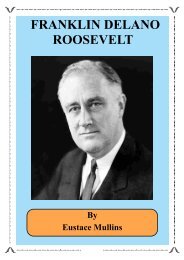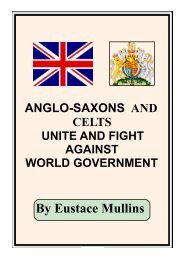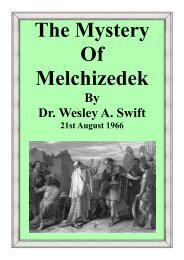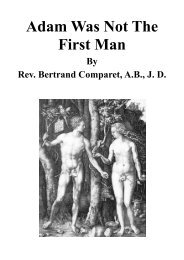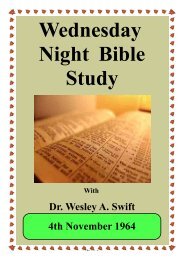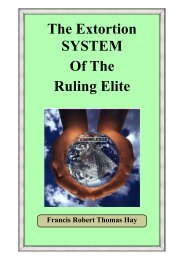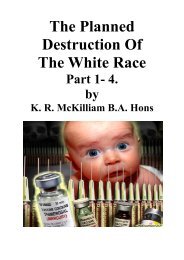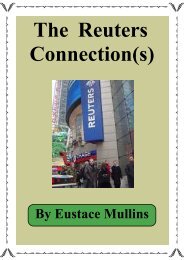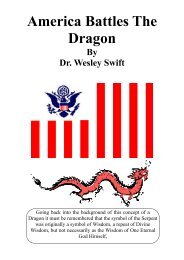Curse of Cannan - The New Ensign
Curse of Cannan - The New Ensign
Curse of Cannan - The New Ensign
Create successful ePaper yourself
Turn your PDF publications into a flip-book with our unique Google optimized e-Paper software.
VII issued "In eminenti," which condemned Masonry for its naturalism and its demand for oaths.<br />
Benedict XIV condemned Masonry in his "Providas" edict, May 18, 1751; Pius VII in<br />
"Ecc1esiam," September 13, 1821; Leo XIII, "Quo graviora," March 13, 1825; Gregory XVI,<br />
"Mirari," August 15, 1832; Pius IX in six separate edicts dating from 1846-1873; Leo XIII, five<br />
edicts condemning Freemasonry from 1882-1902. Gen. Pike responded by terming the papacy<br />
"a deadly, treacherous enemy" in his letter to the Italian Grand Master Timoteo Riboli. "<strong>The</strong><br />
Papacy has been for a thousand years the torturer and curse <strong>of</strong> Humanity, the most shameless<br />
imposture, in its pretence to spiritual power <strong>of</strong> all ages."<br />
Despite these edicts, the Catholic Duke <strong>of</strong> Norfolk became Grand Master <strong>of</strong> English Masons in<br />
1730; the Catholic Viscount Montagu, the ninth Lord Petre, who was the head <strong>of</strong> English<br />
Catholics, was also the Grand Master <strong>of</strong> England from 1772-77. On March 19, 1902, in the fifth<br />
<strong>of</strong> his edicts condemning Freemasonry, Pope Leo XIII said, "Freemasonry is the personification<br />
<strong>of</strong> the Revolution .... whose aim is to exercise an occult overlords hip upon society and whose<br />
sole raison d'etre consists in waging war against God and His Church." What a pity that Pope<br />
Leo XIII did not know about the <strong>Curse</strong> <strong>of</strong> Canaan, or that Freemasonry was simply Satan's<br />
rebellion against God, which was being carried on in the twentieth century by his descendants,<br />
the Canaanites.<br />
<strong>The</strong> heads <strong>of</strong> English Masonry during the nineteenth century were the Duke <strong>of</strong> Sussex, younger<br />
son <strong>of</strong> King George II, 1813-43; the Earl <strong>of</strong> Zetland, 1843-70; the Marquess <strong>of</strong> Ripon, 1870; the<br />
Earl <strong>of</strong> Limerick, 1871; the Prince <strong>of</strong> Wales, later King Edward VII, 1874; Hugh David<br />
Sandeman, <strong>of</strong> the prominent wine importing family, 1895; Lord Ampthill, 1908; the Duke <strong>of</strong><br />
Connaught, to 1938. <strong>The</strong>se were all leading aristocrats; the Earl <strong>of</strong> Zetland married the daughter<br />
<strong>of</strong> the Earl <strong>of</strong> Scarborough, later appointed Viceroy <strong>of</strong> Ireland 1889-92; he was the brother-in-law<br />
<strong>of</strong> the Duke <strong>of</strong> Westminster, the wealthiest man in England; the second Marquess <strong>of</strong> Zetland,<br />
Lawrence Dundas, bore the Sword <strong>of</strong> State at the coronation <strong>of</strong> King George VI; he was also<br />
Governor <strong>of</strong> the National Bank <strong>of</strong> Scotland, chairman <strong>of</strong> the National Trust, Governor <strong>of</strong> Bengal;<br />
he headed the Round Table Conferences <strong>of</strong> 1930-32, was Secretary <strong>of</strong> State for India 1935-40,<br />
was admitted to the Order <strong>of</strong> St. John <strong>of</strong> Jerusalem, and he wrote the biographies <strong>of</strong> England's<br />
two leading figures, Lord Cromer, head <strong>of</strong> Baring Brothers banking house, and Lord Curzon,<br />
Governor-General <strong>of</strong> India.<br />
<strong>The</strong> Marquess <strong>of</strong> Ripon, George Frederick Samuel, was born at 10 Downing Street while his<br />
father was Prime Minister; he became Secretary <strong>of</strong> War and Secretary for India under Lord<br />
Palmerston, and was appointed First Lord <strong>of</strong> the Admiralty under Gladstone. He was Colonial<br />
Secretary 1892-95, Lord Privy Seal in the House <strong>of</strong> Lords, and leader <strong>of</strong> the Liberal Party, 1905-<br />
08. His name is memorialized in the United States by the Ripon Society, a group <strong>of</strong> "liberal"<br />
Republicans who have exercised considerable influence from behind the scenes on the policies<br />
<strong>of</strong> the Republican Party.<br />
<strong>The</strong> present Earl <strong>of</strong> Limerick, Patrick Pery, is deputy chairman <strong>of</strong> the international banking house,<br />
Kleinwort Benson.<br />
<strong>The</strong> second Marquess <strong>of</strong> Ripon resigned as Grand Master in 1894 and joined the Catholic Church;<br />
he was treasurer <strong>of</strong> Queen Alexandra's household (wife <strong>of</strong> King Edward VII) 190 1- 1923; he<br />
was brother-in-law to the Earl <strong>of</strong> Pembroke, and he married the widow <strong>of</strong> the fourth Earl <strong>of</strong><br />
Lonsdale.<br />
Lord Ampthill's father, Odo W. Russell, served in Lord Palmerston's <strong>of</strong>fice from 1850-52; he<br />
served with the Florence legation from 1957 - 70 and was regarded as an un<strong>of</strong>ficial ambassador<br />
to the Vatican during those years; he was then sent as Special Envoy to the German Army<br />
Headquarters It Versailles during the Franco-Prussian War. He later served IS British<br />
Ambassador to. Vienna and Berlin. <strong>The</strong> second Baron Ampthill was Grand Master <strong>of</strong> English<br />
Masons from 1908 to his death in 1935. This is the same Russell family which holds the title <strong>of</strong><br />
( Page 51)



